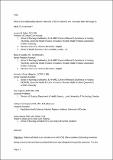Files in this item
What is the relationship between elements of ICU treatment and memories after discharge in adult ICU survivors?
Item metadata
| dc.contributor.author | Aitken, Leanne M. | |
| dc.contributor.author | Castillo, Maria I. | |
| dc.contributor.author | Ullman, Amanda | |
| dc.contributor.author | Engström, Åsa | |
| dc.contributor.author | Cunningham, Kathryn | |
| dc.contributor.author | Rattray, Janice | |
| dc.date.accessioned | 2021-03-12T11:30:14Z | |
| dc.date.available | 2021-03-12T11:30:14Z | |
| dc.date.issued | 2016-02-01 | |
| dc.identifier | 250890075 | |
| dc.identifier | abe386d6-1a8e-427d-92c7-c5f8c69fabfc | |
| dc.identifier | 84959176978 | |
| dc.identifier.citation | Aitken , L M , Castillo , M I , Ullman , A , Engström , Å , Cunningham , K & Rattray , J 2016 , ' What is the relationship between elements of ICU treatment and memories after discharge in adult ICU survivors? ' , Australian Critical Care , vol. 29 , no. 1 , pp. 5-14 . https://doi.org/10.1016/j.aucc.2015.11.004 | en |
| dc.identifier.issn | 1036-7314 | |
| dc.identifier.other | Bibtex: urn:28ed15f0e711db6e32ed9a3333707333 | |
| dc.identifier.other | ORCID: /0000-0002-3300-7220/work/60631173 | |
| dc.identifier.uri | https://hdl.handle.net/10023/21622 | |
| dc.description.abstract | Objectives: Patients admitted to an intensive care unit (ICU) often experience distressing memories during recovery that have been associated with poor psychological and cognitive outcomes. The aim of this literature review was to synthesise the literature reporting on relationships between elements of ICU treatment and memories after discharge in adult ICU survivors. Review method used: Integrative review methods were used to systematically search, select, extract, appraise and summarise current knowledge from the available research and identify gaps in the literature. Data sources: The following electronic databases were systematically searched: PubMed, Ovid EMBASE, EBSCOhost CINAHL, PsycINFO and Cochrane Central Register of Controlled Trials. Additional studies were identified through searches of bibliographies. Original quantitative research articles written in English that were published in peer-review journals were included. Review methods: Data extracted from studies included authors, study aims, population, sample size and characteristics, methods, ICU treatments, ICU memory definitions, data collection strategies and findings. Study quality assessment was based on elements of the Critical Appraisal Skills Programme using the checklists developed for randomised controlled trials and cohort studies. Results: Fourteen articles containing data from 13 studies met the inclusion criteria and were included in the final analysis. The relatively limited evidence about the association between elements of ICU treatment and memories after ICU discharge suggest that deep sedation, corticoids and administration of glucose 50% due to hypoglycaemia contribute to the development of delusional memories and amnesia of ICU stay. Conclusions: The body of literature on the relationship between elements of ICU treatment and memories after ICU discharge is small and at its early stages. Larger studies using rigorous study design are needed in order to evaluate the effects of different elements of ICU treatment on the development of memories of the ICU during recovery. | |
| dc.format.extent | 10 | |
| dc.format.extent | 554942 | |
| dc.language.iso | eng | |
| dc.relation.ispartof | Australian Critical Care | en |
| dc.subject | Critical care | en |
| dc.subject | Delusion | en |
| dc.subject | Evidence based nursing | en |
| dc.subject | Memory | en |
| dc.subject | Psychological recovery | en |
| dc.subject | RT Nursing | en |
| dc.subject | NDAS | en |
| dc.subject.lcc | RT | en |
| dc.title | What is the relationship between elements of ICU treatment and memories after discharge in adult ICU survivors? | en |
| dc.type | Journal item | en |
| dc.contributor.institution | University of St Andrews. School of Medicine | en |
| dc.identifier.doi | 10.1016/j.aucc.2015.11.004 | |
| dc.description.status | Peer reviewed | en |
This item appears in the following Collection(s)
Items in the St Andrews Research Repository are protected by copyright, with all rights reserved, unless otherwise indicated.

